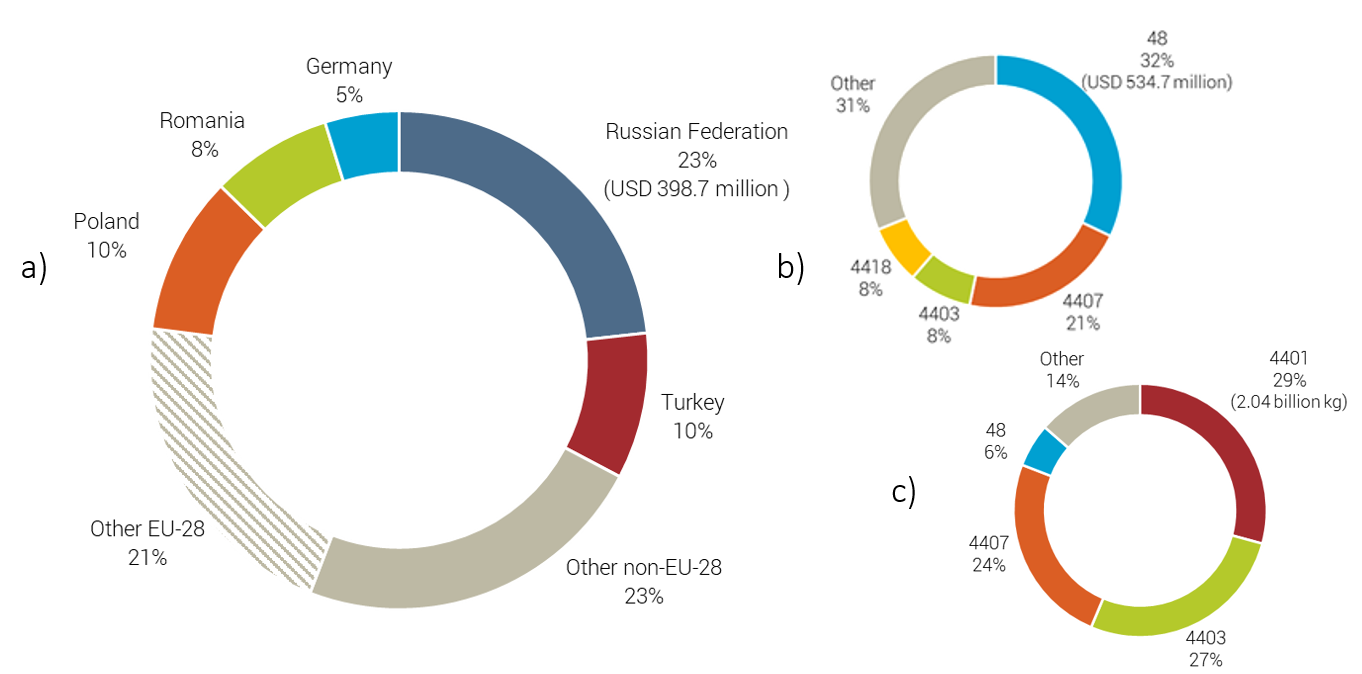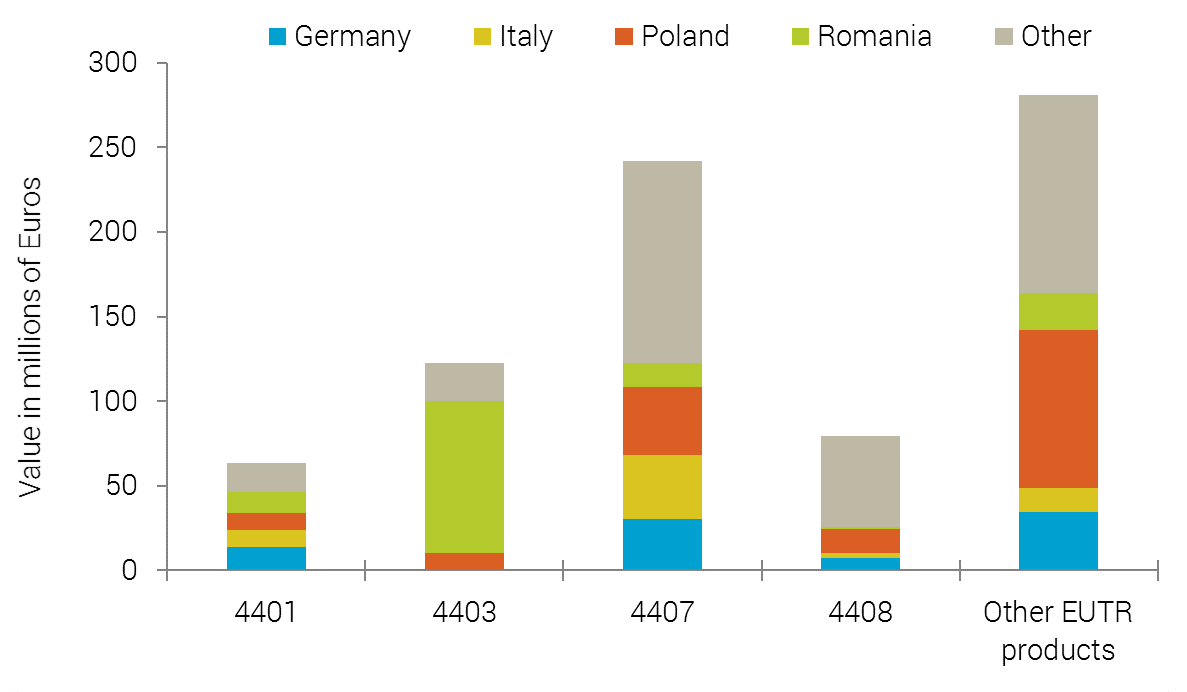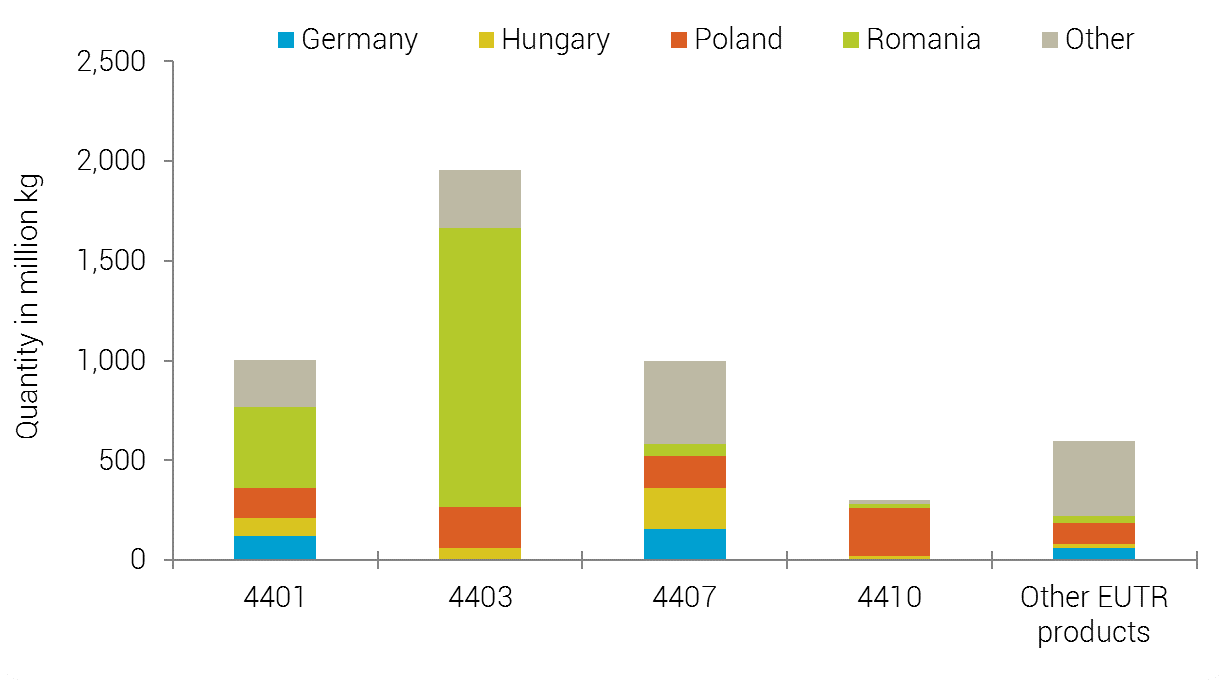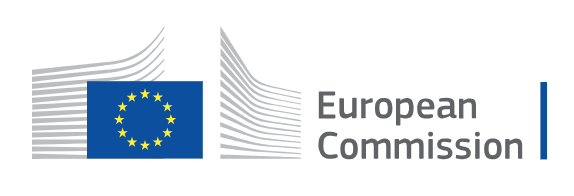LAND AREA:
FORESTED
AREA:
FOREST
TYPE:
LAND
OWNERSHIP:
PROTECTED
AREAS:
VPA STATUS:
57.9 million hectares¹
9.7 million hectares²
16.7% of total land area²
0.6% primary²
49.1% naturally regenerated²
98% government administered²
<1% private ownership²
2.4 million hectares³
11% of forests found in Protected Areas²
No VPA currently⁴
ECONOMIC VALUE OF FOREST SECTOR:
USD 1.5 billion in 2011⁵
1% of the GDP in 2011⁵
25th highest exporter of EUTR products globally in 2015 by weight (kg)⁶
45th highest exporter of EUTR products globally in 2015 by value (USD)⁶
ANNUAL DEFORESTATION RATE:
86 thousand hectares of tree cover loss in 2017⁷
Average of 65 thousand hectares per year 2013–2017⁷
CERTIFIED FORESTS:
FSC certification: 4.1 million hectares (2018)⁸
PEFC certification: 0 hectares (2017)⁹
CHAIN OF CUSTODY CERTIFICATION:
FSC certification: 231 CoC certificates (2018)⁸
PEFC certification: 0 (2017)⁹
MAIN TIMBER SPECIES IN TRADE:
Silver fir (Abies alba), common alder (Alnus glutinosa), common silver birch (Betula pendula), hornbeam(Carpinus spp.), European beech (Fagus sylvatica), European ash (Fraxinus excelsior), Norway spruce (Picea abies), Scots pine (Pinus sylvestris), English oak (Quercus robur)¹⁰
CITES-LISTED TIMBER SPECIES:
None¹¹
RANKINGS IN GLOBAL FREEDOM AND STABILITY INDICES:
Rule of law index¹²
3rd quarter
77/113 in 2017
Corruption perception index¹³
3rd quarter (score: 30)
130/180 in 2017
Fragile states index¹⁴
2nd quarter
86/178 in 2018
(Inverse scoring system)
Freedom in the world index¹⁵
2nd quarter
38/83 in 2018
LEGAL TRADE FLOWS
In 2015, Ukraine’s export of EUTR-regulated products (timber and timber products to which the EUTR applies) totalled 7.63 billion kg, of which 62.4% was exported to the EU-28. Exports of EUTR-regulated products mainly consisted of paper products (HS48*) by value and fuel wood (HS4401) by weight (Figures 1b and 1c); Ukraine imported very little timber and consumed the majority of its roundwood production (Table 1). Sawn wood (4407) also represented a large proportion of exports by both weight and value, indicating the high value of the product. The majority (54%) of EUTR products were exported to countries neighbouring Ukraine, with the Russian Federation the single largest importer in 2015 (Figure 1a). The EU imported less than 1% of Ukraine’s exported EUTR products by weight, but nearly half (48%) by value. The majority of EUTR products imported into the EU from Ukraine in 2015 were imported by Poland and Romania, followed by Italy and Germany.

Figure 1: a) Main global markets for EUTR products from Ukraine in 2015 in USD; b) main EUTR products by HS code exported from Ukraine by value in USD in 2015; and c) main EUTR products by HS code exported from Ukraine by weight (kg) in 201517.
Table 1: Production and trade flows of main timber products in Ukraine in 201510.
| Production (x 1000 m³) |
Imports (x 1000 m³) |
Domestic consumption (x 1000 m³) |
Exports (x 1000 m³) |
|
| Logs (industrial roundwood) | 18 337 000 | 14 000 | 13 121 000 | 5 230 000 |
| Sawnwood | 1 804 000 | 7000 | 295 000 | 1 516 000 |
| Veneer | 110 000 | 4000 | 48 000 | 66 000 |
| Plywood | 177 000 | 50 000 | 33 000 | 195 000 |

Figure 2: Value of EU imports of EUTR products from Ukraine to the EU in 2015 by HS code. Producing using data from EUROSTAT16.

Figure 3: Quantity of EU imports of EUTR products from Ukraine to the EU in 2015 by HS code. Producing using data from EUROSTAT16.
*Key to HS codes: 4401 = fuel wood; 4403 = rough wood; 4407 = sawn wood; 4408 = veneer sheets; 4410 = particle board; 4418 = joinery and carpentry wood; 48 = paper and paper products
KEY RISKS FOR ILLEGALITY
COMPLIANCE WITH LEGISLATION:
The State Forest Enterprises may be implicated in illegal logging, making investigation and prosecution difficult18,19.
BRIBERY INCIDENCE:
50.4% of firms experiencing at least one bribe payment request in 201320
ILLEGAL HARVESTING OF SPECIFIC TREE SPECIES:
Average annual volume of illegal logging has been estimated between 20 000 m³ (in 2008 by the State Forest Agency) and 1.25 million m3 (by a Swiss-Ukrainian Forest Development Project in 2010)21.
Sanitary logging considered the principal means of illegal logging since the late 1990s22. In 2017, the share of sanitary logging on total harvest was estimated at around 30–40%23,24.
PREVALENCE OF ILLEGAL HARVESTING OF TIMBER:
Beech and oak have been reported as higher risk species25.
RESTRICTIONS ON TIMBER TRADE
EU ban on import of goods from Crimea and Sevastopol26,27.
Exports of raw logs were banned for 10 years from 1st November 201528; pine trees were included in this ban from 1st January 201729.
Exports of timber (HS 4403) and sawn wood (HS 4407) from valuable tree species is prohibited, including: acacia, Sorbus torminalis, cherry tree, pear, walnut, chestnut, yew, bird-cherry, sycamore and juniper28. Harvest of species listed in the Red Book of Ukraine (inc. Juniperus excelsa, Sorbus torminalis, Taxus baccata and Cerasus klokovii) is also prohibited30.
COMPLEXITY OF THE SUPPLY CHAIN
The State Forest Resources Agency of Ukraine (SFRAU) controls 73% of Ukrainian forests24,30. 272 State Forest Enterprises (SFEs) subordinated to SFRAU are in charge of managing these forests24. Logging operations are managed by SFEs either directly or through private contractors24. The remaining 27% of forests are in permanent use by other central government bodies and municipalities24. Regional Forest and Hunting Departments of SFRAU monitor the activities of SFEs, and are in charge of issuing logging permits for final felling24. SFEs have the authority to issue logging permits for sanitary felling24
Illegal trade
Although Ukrainian legislation does not offer a direct definition of illegal logging18,21, logging of trees and bushes is considered illegal when it is carried out without a permit or is in violation of the law, or when the logging operations contravene the production volume, timeframe, location or species specified on the permit21.
Common forms of larger scale illegal logging involve unnecessary sanitary logging and use of legitimate papers to launder illegal timber19,25,30, particularly in the Carpathian region of Ukraine18,22. Undocumented logging in areas not designated for harvest in the Ukrainian Carpathians was reported to have been widespread 1988-200722. Unnecessary sanitary logging was reported to have become a stable source of timber procurement from protected and commercial forests21, with a 2011 study showing a 6 to 7-fold increase of selective sanitary cutting (unrelated to natural disasters) over the previous 15-20 years31. Non-profit organisation Earthsight reported that, based on official SFRAU figures, the amount of timber harvested under sanitary logging in the Ukrainian Carpathians in 2016 was greater than the amount cut under the pre-planned Annual Allowable Cut (AAC)19. Nationwide, the volume of timber cut under ‘sanitary’ logging in 2017 was reported to have reached 12.4 million m3, exceeding the 9.4 million m3 cut as part of the planned felling19; it is unclear what proportion of this sanitary logging was illegal. Localised “unauthorised harvesting” of timber for wood fuel and minor home repairs was also reported to occur18.
In a 2017 national risk assessment, FSC identified a range of specified risks, including that: according to evidence provided by some nature conservation NGOs, some sanitary cuttings are planned in violation of legislation and/or silvicultural requirements; there is a shortage of documentary evidence of land-use rights for communal, private and state enterprises that are beyond SFRAU jurisdiction; underestimating the amount of rent specified in harvesting tickets, through incorrect assessment of volumes, species composition and size-quality characteristics of the wood; understatement of taxes due to illegal sale of wood or sale with misstating of wood category, grade and volume; violations related to timber transportation by road without any logistics documents; and violations by enterprises subordinated to SFRAU concerning non-compliance with requirements on selling all wood through auctions30. There were noted to be substantial discrepancies between official statistics of illegal and unauthorised logging and figures reported from unofficial sources30.
In a 2010 survey, forest experts in Ukraine reported a large number of unregistered sawmills, and a system for purchasing stolen timber in the Ivana-Frankivsk area18. Incidents of corruption in the same area were also reported, including bribing forestry officials, land fraud and issuing illegal harvesting permits18. Two thirds of local residents surveyed in the Carpathian region (800 of 1200 respondents) believed that there was overcutting of the forest in their locality, with more than half reporting an increase in volume over the previous five years18. By 2017, there were estimated to be 12 000 unlicensed sawmills operating in Ukraine, compared with 9200 legal ones32,19. Exports of sawn timber in 2016 were estimated to be 50 per cent more than that recorded as having been legally produced in the country’s sawmills19.
In their 2018 report, Earthsight considered timber corruption in the Ukraine to be pervasive, extending from the lowest level forest ranger to national forestry chiefs, with illegality permeating the supply chain from harvest to export19. Their analysis of court records 2017-2018 revealed numerous investigations filed in Ukrainian courts against SFEs for forging documents, receiving bribes from timber companies and causing losses to state revenues by illegally undervaluing timber at auctions. The Prime Minister of Ukraine announced on 18 July 2018 a crackdown on illegal logging and timber smuggling, initiating large-scale inspections of forestry enterprises and signing an appeal to the Prosecutor General to verify the facts of violations33.
Various social and economic factors have been identified as contributing to the occurrence of illegal logging, such as unemployment and poverty in rural areas, low salaries of state forestry officials and employees and the higher profit margins of sanitary cutting relative to final felling21. The legal status and definition of Forest Guards’ roles in forest control is also not clear in Ukrainian legislation21, which can hamper forest law-enforcement; inter-agency cooperation is also low18. A 2010 World Bank analysis of corruption risk in Ukrainian legislation found 12 areas of potential risk, including lack of transparency in the activities of the State Forestry Commission, policies of issuing on the spot fines without the need for receipts, emphasis on punishment rather than reducing violations and lack of clarity on when infractions constitute crimes rather than offences18.
Despite the 2015 ban on export of round logs, export of logs to the EU was reported to have continued, often mis-classified as ‘fuel-wood’; for example, Earthsight reported that in the first half of 2018, Ukrainian customs agents on the border with Romania detected illegal log exports worth >USD 1 million19. Since 12 January 2017, SFE’s have been required to limit the length of any wood exported as fuelwood to two meters34.
Forestry management and legislation
Subsequent to the 2004 Ministerial Conference for Europe and Northern Asia on Forest Law Enforcement and Governance (ENA-FLEG) workshop and Ukraine’s approval of the workshop’s Indicative Action Plan, the State Forestry Committee of Ukraine launched a number of actions including working to amend legislation to make forestry operations more environmentally sustainable, establishing a transparent timber market and working to certify forests used by state run forest companies between 2006 and 200818. In 2015, Ukraine introduced further amendments to existing legislation to strengthen biodiversity protection in Ukraine, including temporary bans on the export of rough wood, and discussing the development of new provisions for timber trade35.
Sanitary cutting/logging is controlled by the State Ecological Inspection of Ukraine, as established in a resolution regarding rules on sanitary cutting in Ukraine (Resolution No. 555, 27 July 1995)35. The resolution also establishes where sanitary felling is prohibited (including within protected areas of biosphere reserves, natural reserves and around nesting areas for birds listed in the Red Book of Ukraine)35. According to the resolution, administrative procedures for obtaining a logging permit for sanitary felling vary depending on whether a felling is selective or clear24. In both cases, SFEs have the authority to issue logging permits along with a number of supporting documents24. For selective sanitary felling, an inspection of the State Enterprise for Forest Pathology and the State Forest Management Planning Enterprise are needed24. For sanitary clear felling, the above is required as well as approval of a Special Commission consisting of representatives of municipalities and the civil society24. This has been linked to a delay in removal of trees infested with bark beetle24. In cases where sanitary felling is conducted in protected areas, the Ministry of Environment inspects the felling site and has to approve the potential sanitary felling24.
The issue of sanitary felling is also linked to wood auctioning procedures24. SFEs subordinated to SFRAU are required to organise auctions for sales of wood harvested from final felling24,30, but there are no regulations on selling wood harvested from sanitary felling. SFEs can therefore choose to sell such wood in auctions or through direct contracts (with civil society organisations noting that direct contracting involves higher risk of illegal timber sales)24.
| RELEVANT LEGISLATION AND POLICY[1] | ||
| For further details on Ukrainian legislation relevant to EUTR, see: FSC (2017) ‘FSC National Risk Assessment of Controlled Wood for Ukraine’ and the Ukraine country page on FAOLEX. | ||
| The Forest Code, 1994, № 3852-ХІІ
Ukrainian Land Code, 2001, № 2768-ІІІ State Specific Programme for the Forests of Ukraine for the Years 2010-2015 On Environmental Protection, 1991, № 1264-ХІІ National Ukrainian Program of National Ecological Network for 2000-2015, 2000, № 1989-ІІІ Nature-Reserve Fund in Ukraine, 1992, № 2456-ХІІ Regulation of Verkhovna Rada of Ukraine on the Main Directions of the State Policy of Ukraine on Environmental Protection, Use of Natural Resources and Ecological Safety Amendments to some legislative acts of Ukraine on protection of Biodiversity, 2015, № 25 Regulation on Allocation of Forests into Groups, Protective Categories and Protected Forest Lands, 1995, №557 Procedure of Forest Division into Categories and the Allocation of Specially Protected Forest Sites, 2007, № 733 Moratorium on Clear Cutting in Fir-beech Forests of Carpathian Mountains, 2000, № 1436-ІІІ Temporary Instruction on Electronic Accounting of Logging, Sawmill and Wood-processing Products at Enterprises of the State Agency of Forest Resources of Ukraine, 2012, № 202 Specifics of State Regulation of Activities of Subjects of Entrepreneurial Activity Related to Selling and Exporting Timber, 2005, № 2860-IV Special Form of the Waybill for Timber Transportation by Road, 2013 № 961/707 |
Regulation on judicial practice in cases of crimes and other offences against the environment, 2004, № 17
Rates to calculate damages inflicted to forest management, 1996, № 1464 Concept for the Reform and Development of Forestry, 2006 Instruction on the Approval and Adoption of the Annual Allowable Cut, 2007, № 38 Regulation on Forest Stands Removal in Ukraine, 1999, №1378 Regulation on Industrial Felling in Ukrainian Forests, 1995, №559 Regulation on Silvicultural Felling, 1996, №535 Regulation on Resin Harvest in Ukrainian Forests, 1996, № 185 Regulation on Second-Quality Timber Harvest and Non-Timber Products and Services in Ukrainian Forests, 1996, № 449 Sanitary regulations in Ukrainian Forests, 1995, №555
Fixed Rates for Forest Tree stands and Resin, 1997, № 44 Regulation on Reforestation and Afforestation, 1996, № 97 Guidelines in Planning, Technical Approval, Inventory and Primary Quality Evaluation of Planted Forest, 1997, №62 Regulation on the state forest inventory and forest cadastre, 1995, № 767 Guidelines on State Forest Cadastre and Primary Forest Inventory, 1997, №62 Regulation on levy for forest resource exploitation and forest land use, 1998, № 1012 Guidelines on levy for forest resource exploitation and forest land, 1999, №91/241/129/236/565 |
|
| LEGALLY REQUIRED DOCUMENTS[2] | ||
| Certificate of timber origin issued by Regional Forest Departments (required for products under HS codes: 4401 10 00 00; 4401 21 00 00; 4401 22 00 00; 4403; 4404; 4406; and 4407)
Felling tickets issued by Regional Forest Departments and by State Forest Enterprises Waybill of transportation issued by the State Forest Enterprises |
Invoice issued by the selling party (must include name of product, species and volume)
Customs documentation issued by the customs authorities (including phytosanitary certificate) |
|
[1] The following list may not be exhaustive and is intended as a guide only on relevant legislation.
[2] The following list may not be exhaustive and is intended as a guide only on required documents.
References
- FAO. FAO Country Profiles: Ukraine. (2018). Available at: http://www.fao.org/countryprofiles/index/en/?iso3=UKR. (Accessed: 13th June 2018)
- FAO. Global Forest Resources Assessment 2005. 244 (2015).
- UNEP-WCMC. Protected Area Profile for Ukraine from the World Database of Protected Areas. (2018). Available at: https://www.protectedplanet.net/country/UA. (Accessed: 2nd July 2018)
- EU FLEGT Facility. VPA countries. (2018). Available at: http://www.euflegt.efi.int/vpa-countries. (Accessed: 2nd July 2018)
- FAO. Contribution of the forestry sector to national economies, 1990-2011, by A. Lebedys and Y. Li. Forest Finance Working Paper FSFM/ACC/09 (Food and Agricultural Organization of the United Nations, 2014).
- United Nations Statistics Division. UN Comtrade Database. (2018). Available at: https://comtrade.un.org/data/. (Accessed: 2nd July 2018)
- Global Forest Watch. Ukraine Country Profile. (2018). Available at: http://www.globalforestwatch.org/country/UKR. (Accessed: 2nd July 2018)
- FSC. Facts and figures August 2018. (Forest Stewardship Council, 2018).
- PEFC. PEFC Global Certification: Forest Management & Chain of Custody. (2017). Available at: https://www.pefc.org/resources/webinar/747-pefc-global-certification-forest-management-chain-of-custody. (Accessed: 2nd July 2018)
- European Timber Trade Federation. Country profile Ukraine. (2018). Available at: http://www.timbertradeportal.com/countries/ukraine/. (Accessed: 2nd July 2018)
- UNEP-WCMC. The Species+ Website. Nairobi, Kenya. Compiled by UNEP-WCMC, Cambridge, UK. (2018). Available at: https://speciesplus.net/. (Accessed: 2nd July 2018)
- World Justice Project. Rule of Law Index 2017-2018. (2018). Available at: http://data.worldjusticeproject.org/. (Accessed: 2nd July 2018)
- Transparency International. Corruption Perceptions Index 2017. (2018). Available at: https://www.transparency.org/news/feature/corruption_perceptions_index_2017. (Accessed: 2nd July 2018)
- Fund for Peace. Fragile States Index 2018. (2018). Available at: http://fundforpeace.org/fsi/. (Accessed: 2nd July 2018)
- Freedom House. Freedom in the World. (2018). Available at: https://freedomhouse.org/report/freedom-world-2018-table-country-scores. (Accessed: 2nd July 2018)
- European Commission. Eurostat. (2018). Available at: http://ec.europa.eu/eurostat/data/database. (Accessed: 2nd July 2018)
- United Nations Statistics Division. UNCOMTRADE database. (2017). Available at: https://comtrade.un.org/data/. (Accessed: 12th December 2017)
- World Bank. Forest law enforcement in Ukraine: status, problems, perspectives. Part one. (World Bank, 2010).
- Earthsight. Complicit in corruption: how billion-dollar firms and EU governments are failing Ukraine’s forests. (Earthsight, 2018).
- World Bank. DataBank World Development Indicators. (2017). Available at: http://databank.worldbank.org/data/reports.aspx?source=2. (Accessed: 26th April 2017)
- Pavelko, A. & Skrylnikov, D. Illegal logging in Ukraine: Diagnostic audit. (Regional Environmental Center, 2010).
- Kuemmerle, T. et al. Forest cover change and illegal logging in the Ukrainian Carpathians in the transition period from 1988 to 2007. Remote Sens. Environ. 113, 1194–1207 (2009).
- European Commission. EU TAIEX Mission Report – reform of forest governance in Ukraine, October 2017. (EU TAIEX, 2017).
- European Commission. EU TAIEX Mission Report – reform of forest governance in Ukraine, February 2018. (EU TAIEX, 2018).
- Milakovsky, B. Illegality risk in sourcing from Russia and Ukraine. (WWF, 2016).
- European Commission. European Union Restrictive measures (sanctions) in force. (European Commission, 2017).
- European Commission. EU sanctions on Ukraine. (EU Sanctions Map, 2018).
- Верховної Ради України [Translation: Verkhovna Rada of Ukraine]. Про особливості державного регулювання діяльності суб’єктів підприємницької діяльності, пов’язаної з реалізацією та експортом лісоматеріалів № 2860-IV [State regulation of entrepreneurial activity, connected with sale and export of timber № 2860-IV]. (Відомості Верховної Ради України [Translation: Bulletin of the Verkhovna Rada of Ukraine], 2006).
- Верховної Ради України [Translation: Verkhovna Rada of Ukraine]. Про внесення змін до Закону України “Про особливості державного регулювання діяльності суб’єктів підприємницької діяльності, пов’язаної з реалізацією та експортом лісоматеріалів” щодо тимчасової заборони експорту лісоматеріалів у необробленому вигляді [Tr. (Відомості Верховної Ради України [Translation: Bulletin of the Verkhovna Rada of Ukraine], 2015).
- FSC. FSC National Risk Assessment of Controlled Wood for Ukraine. (Forest Stewardship Council, 2017).
- World Bank. Forest law enforcement in Ukraine: status, problems, perspectives. Part two. (World Bank, 2011).
- BRDO. The budget of Ukraine loses 200 million hryvnas annually because of illegal sawmills. Better Regulation Delivery Office press release, 27 July 2017. (2017). Available at: http://en.brdo.com.ua/main/brdo-budget-ukraine-loses-200-million-hryvnas-annually-illegal-sawmills/. (Accessed: 19th July 2018)
- Ukraine Government. Prime Minister initiates large-scale inspections of forestry enterprises for forest smuggling and signed an appeal to the Prosecutor General to verify the facts of violations, 18 July 2018. (2018). Available at: https://www.kmu.gov.ua/en/news/glava-uryadu-iniciyuye-masshtabni-perevirki-lisgospiv-na-predmet-kontrabandi-lisu-i-pidpisav-zvernennya-do-genprokuraturi-pro-perevirki-faktiv-porushen. (Accessed: 18th July 2018)
- Ukraine Government. ´Держлісагентство унеможливило експорт ділової деревини під виг лядом дров´, January 12, 2017,. (2017). Available at: https://www.kmu.gov.ua/ua/news/249651370. (Accessed: 18th July 2018)
- Verkhovna Rada. On amendments to some legislative acts of Ukraine on protection of biodiversity. (2015).


